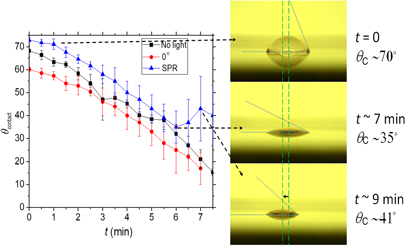Published online by Cambridge University Press: 15 July 2019

Excitation of surface waves on conducting materials provides a near resistance-free interface capable of a material glissade either by plasmon forces or by optical beam tractors. Analogous to an ice hockey rink, as proof-of-principle plasmon-assisted optical traction, or hoovering, of water drops on a gold surface is demonstrated. Changes in the contact angle provide a novel, low-cost nanoscale method of quantifying observable and potentially tunable changes. Variability in thresholds and movement, including jumps, is observed and can be explained by the presence of significant roughness, measured by scanning electron microscopy, with water tension. The demonstration opens a path to directly integrate various optical and plasmonic traction technologies. Implications of the phenomena and ways of improving transport and potential applications spanning configurable microfluidics, antennas, tunable lenses, diagnostics, sensing, and active Kerr and other devices are discussed.